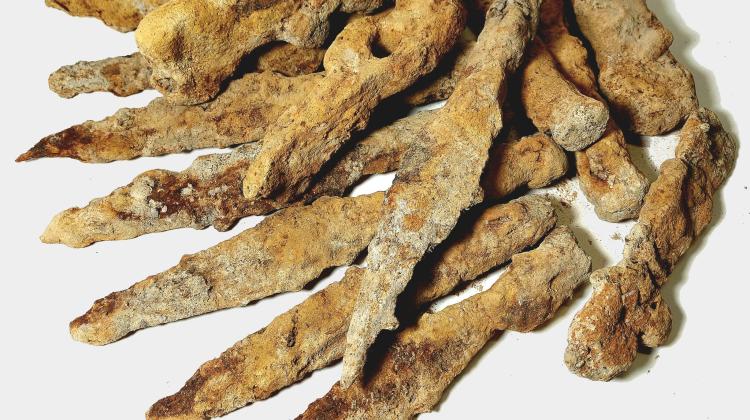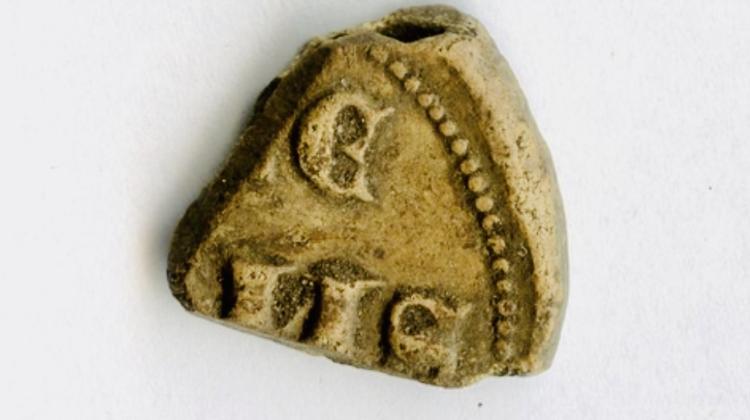Weapons of barbarian tribes from Roman times discovered near Hrubieszów
 Source: Facebook/ Lublin Provincial Conservator of Monuments
Source: Facebook/ Lublin Provincial Conservator of Monuments
Iron spearheads, two battle axes and a wood-cutting axe are among the items discovered near Hrubieszów by treasure hunters. The weapons most likely come from Roman times and were used by warriors from barbarian tribes.
The Lublin Provincial Conservator of Monuments announced the discovery on social media.
According to the conservator, treasure hunters searching in the State Forests near Hrubieszów found a cluster of several iron artefacts. 'At first, due to the very strong corrosion covering the metal, additionally mixed with sand and mud, it was difficult to determine what these objects were,’ he says.
All the artefacts were located almost in one place, shallow in the forest floor, in an area degraded by heavy forestry equipment and partly by animal activity. 'These circumstances led to the discovery of initially one object on the surface, and another one a moment later. Several kilograms of shapeless, muddy, corroded iron were safely packed and taken from the forest with the intention of cleaning and determining the nature of the find,’ the conservator says.
The finders contacted the Hrubieszów museum, which received the entire find along with a report on the circumstances of the discovery and the approximate site location. 'Archaeologists from this Museum - Bartłomiej Bartecki and Anna Hyrchała - carried out a preliminary analysis and assessment of these finds. Moreover, the analysis of the Archaeological Image of Poland (the national and provincial register of archaeological monuments - PAP) documentation shows that so far there have been no known archaeological sites in the area of discovery of these artefacts,’ the conservator adds.
The discovery consists of a dozen or so items, including: iron spearheads (25.5 cm to 34.5 cm long, with the width of the leafy blade between 5 cm and 6.5 cm); two iron battle axes (one 23.5 cm long and 7 cm high, the other slightly smaller, 19 cm long and 5 cm high); one shaft-hole axe (or carpenter axe - this will most likely be determined only after conservation); and three items whose identification is currently very difficult (also requiring conservation).
Archaeologists already have a preliminary theory about the origin of the weapon. 'First of all, we are most likely dealing with weapons used by barbarian tribes during the times of the Roman Empire. Perhaps they were used by warriors who belonged to the so-called Przeworsk culture (1st century BCE - 2nd/3rd century CE), identified by archaeologists as members of the Vandal tribe, or the communities from the Gothic cultures (2nd/3rd century CE - 5th century CE),’ the conservator says.
Close to the place where the monuments were found, a damaged grave of a Przeworsk culture warrior was discovered many years ago, during the construction of the Border Guard Post in nearby Horodło, considered the northernmost site of this culture.
'The number of artefacts, their nature, method of deposition and state of preservation exclude the possibility of a cemetery or a single burial in this place. No bones or fragments of pottery that should have been in the grave pit were found during field verification,’ the conservator says.
He adds that everything indicates that someone deliberately collected these elements, packed them in a bag or another organic container (no trace of which has been preserved) and then threw them into the swamp.
The conservator has transferred the monuments to the collection of the Stanisław Staszic Museum in Hrubieszów, which will immediately begin securing and maintaining them. 'Only after these procedures will it be possible to properly determine the nature of the discovery in question and its chronological and cultural affiliation,’ the conservator says.
The place where the weapons were discovered will be re-examined in spring, under more favourable weather conditions.
The Stanisław Staszic Museum in Hrubieszów also commented on the discovery saying: 'For many years, while showing our visitors around, we have mentioned that there must be weapons used by the Goths in the soil somewhere in the Hrubieszów area. Remember that the Goths did not place iron objects in their graves. These spears, swords, axes and other military equipment must be somewhere and it is only a matter of time before we find one of such places.’ (PAP)
Magdalena Barcz
bar/ agt/ kap/
tr. RL
Przed dodaniem komentarza prosimy o zapoznanie z Regulaminem forum serwisu Nauka w Polsce.

















